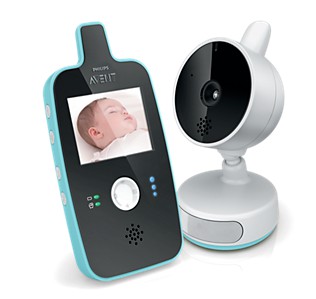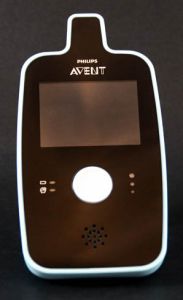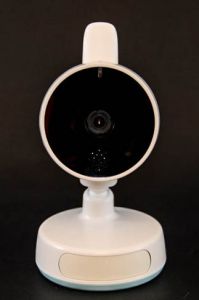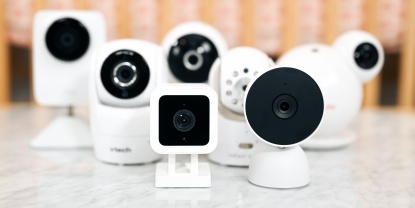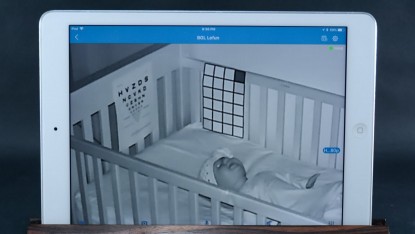Philips Avent Digital Video Baby Monitor Review
Our Verdict
Our Analysis and Test Results
The Philips Avent SCD603/10 is a digital monitor with a 2.4 inch color screen for easy viewing. It has a range up to 150 meters depending on the environment and the parent unit is fully transportable and a wall mountable baby unit. It features automatic infrared night vision for seamless day to night viewing. The monitor sports a backup battery feature in case the electricity goes out and a rechargeable parent unit for mobility. The parent unit can turn on lullabies and nightlights on the baby unit to help soothe baby from a distance. The monitor includes sound activated screen and audio feature for more peaceful monitoring during sleep, and sound level lights for alerts when the volume is down. This unit comes with the camera, parent unit, charging cords, rechargeable battery, belt clip, and a 1 year warranty.
Range
The Philips Avent website says this monitor should get an indoor range of about 30 meters, or for those of use metrically challenged that comes out to about 100 feet or so (we are rounding up a smidge here). However, we assume their claim must be inside without any walls or doors and other obstacles that might interfere with reception, because our tests showed this unit is only good up to 62 feet and 4 walls between baby and parent units. Which, if we are doing our math right, is about 38 feet less than 100. In fairness however, almost all of the manufacturer claims for range proved incorrect in real world scenarios and some were even off in the open field tests where line of sight is maintained.
The manufacturer website says this monitor has an outdoor range of up to 100 meters which is roughly 492 feet. In our test it start to have trouble around 484 feet, so this claims is probably more accurate than their indoor estimations. Keep in mind that indoor range can be effected by walls, floors, and some appliances, so the range you experience might differ from our test in an average home, but this give a better idea than the numbers shown on the box.
The dedicated products with the best score for range are the Infant Optics DXR-8 and Motorola which worked sufficiently well through 5 walls at a distance of 80 feet and earned a 7 out 10 for the metric. The WiFi connected monitors have the longest distance as they are only limited by the internet connection capabilities of your home. The monitor with the worst range is the Foscam which worked up to about 55 feet and through 3 walls.
If your home is large or there is a potential for lots of interference or obstacles between the baby and parent units you might be stuck with WiFi only options to ensure reliable monitoring.
Audio / Visual
The Philips did an admirable job in the sound department, but stumbled and fell a bit in the video testing. It scored an 8 of 10 for sound and features, and only a 4 for the video capabilities.
For sound this unit has a maximum decibel level of 101db. This is a respectable max with several products coming in lower and only a few being louder. It has a better volume control and adjustment than the rest of the monitors and spoken language is easier to understand than some of the competition. The sound is very bright and a little agitating to the ears, but you definitely aren't going to miss a thing, and you'll be able to tell what is happening without guess work.
The sound activation feature will turn off when the sound reaches between 55 and 56db; the sound turns off about 5 seconds after the noise stops and the screen turns off about 3 seconds later. This monitor did a great job for filtering out superfluous white noise and would be an easy one to sleep near given the limited possibility of being kept awake by background noise.
The monitors with the highest score for sound quality and features are the Samsung SafeVIEW and the VTech Safe & Sound, both of which earned a 9. The worst for the group is the Levana Ovia, which only scored a 3. WiFi Baby 3.0 scored a 0 in this test, but this is more related to being unable to keep the monitor going long enough to test, than a true reflection of a sound performance test.
Whatever the Philips did right for sound, they got plain wrong in video. In our tests this monitor had trouble providing a good quality picture in day or night conditions, no matter what settings we used in the menu to help improve the image. For clarity of image we were unable to read any of the lines of the eye chart next to baby in the crib, and baby's facial features were all but non-existent. This is in a standard view as this model does not offer a zoom feature for getting closer to the image.Ease of Use
The monitor is also relatively easy to use on a daily basis. It doesn't have the most intuitive buttons and menus and we had to play with it and do a little trial and error to sort out the details, but we think that once parents get a chance to play with it, it will seem easy and straight forward. It might just be the simplistic design of the parent unit and the lack of extraneous buttons that actually make this model a bit tricky at first, but over time it is easy to use and the menus are easy to navigate. Most of the everyday use buttons like volume and brightness are on the front of the parent unit, making middle of the night adjustments easier to handle than some of the competition.
For ease of use this monitor scored a 7 of 10 which is about average for the group. The top scoring products were the Nest Cam and Summer Infant Clear Sight, which both earned 8s. The hardest product to use is hands down the WiFi Baby 3.0 which took us multiple attempts to set up, including various levels of success, only to resort to contacting customer service and waiting 2 days for an appointment to discuss our concerns. The monitor finally got setup, but the time and effort involved is probably more than the average parent would bother with. As a result, the WiFi Baby earned a 0 for ease of use.
Features
This product earned the lowest score for features because it lacked some of the basic features most parents will be looking for or most of the products came with. Whether or not these features are important to you is what matters, but the inclusion of many of them can make life with a monitor easier or more useful. The Philips earned 2 of 10 for features, which tied with WiFi Baby 3.0 for what it offers. The highest scoring products for features are the Nest Cam and Withings Smart Baby, which all earned a 9 and 10 respectfully in our review of features.
This camera also has night vision and can be used up to 10 feet from baby. The night vision is automatic based on ambient room light. The infrared LEDs are invisible and non-distracting to baby trying to sleep. It comes with a kickstand, belt clip, and wall mounting features.
EMF
All monitors emit EMF, how much and how far away they must be in order to have the least amount of potential impact on baby is what matters. All the products in this review registered 6+ when the reader was placed right next to the cameras, with the exception of the Withings connected via Ethernet cable. This number went down by about half for most of the monitors in the review, and it decreased even more at 6 feet from the camera. Given that most cameras can be placed at least 10 feet away and still get night time images of baby, the amount of EMF baby comes in contact with will be less the further away it gets. The Philips had some of the lowest readings for a dedicated unit, with a 1.79 at 3 feet and 1.29 at 6 feet. The Levana Ayden also read 1.29, and the Nest Cam had a 0.78 reading at 6 feet, the lowest in the group. The WiFi Withings Smart Baby had no EMF when connected via Ethernet cable, making it the best choice for health if you are concerned about EMF.
Battery Life
This product had one of the better battery life results in our test. It lasted 8 hours and has a unique battery backup function. The Summer Infant Clear Sight and Lorex Sweet Peep also lasted 8 hours in our tests, and the Levana Ayden lasted 9.5 hours. The Nest Cam and Withings Smart Baby options battery time is dependent on the device being used as a parent unit, but most of the available options have a fairly long battery life depending on what else they are being used for. The shortest battery life in our test is the Uniden Lullaboo Guardian G403 with 3.5 hours. The extended battery life of the Philips means parents can rest easy that the monitor will continue to alert them through the night, or during an electric outage with the battery back up feature.
Best Applications
Given its lack of features, poor video quality, and higher price tag there is no best application for this monitor. Parents might be drawn to the brand name as one they recognize, but that is not a good enough reason to make this purchase. There are better performing products with more features in our review that have a lower or similar price. Parents do not need to sacrifice the features that they want and only walk away with a bad video.
Value
Given that this product is in the top third pricewise, and more expensive than both award winners, this product does not offer any value with what it brings to the table. In general a product with so few features, and poor performance in our video testing should really cost less than this monitor.
Conclusion
This isn't the worst monitor in our review, and it did offer some strengths in sound and the battery backup feature. However, it didn't offer enough in the metrics for video products that really count. It struggled to offer a good picture, it lacked zoom capabilities, had a small field of view, and didn't have the best range. It is hard to love a product that doesn't even seem to love itself. This simplistic product should either cost less or be of higher performance if it hopes to bring home an award from us. This is not a product we recommend.


